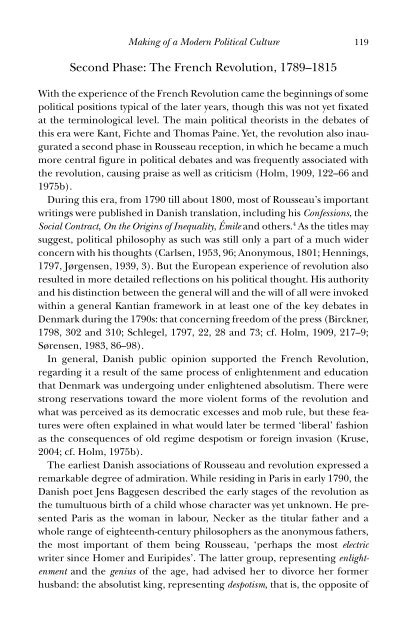Rousseau and Revolution
Rousseau and Revolution
Rousseau and Revolution
Create successful ePaper yourself
Turn your PDF publications into a flip-book with our unique Google optimized e-Paper software.
56 <strong>Rousseau</strong> <strong>and</strong> <strong>Revolution</strong><br />
name to Émile; <strong>and</strong> in April 1794, Bertr<strong>and</strong> Barère denounced counter-<br />
revolutionaries in Marseille who had destroyed busts of <strong>Rousseau</strong> <strong>and</strong><br />
Voltaire. Perhaps signifi cantly, or merely just coincidentally, a fl urry of theatrical<br />
iconicity took place at the moment of the Great Terror (June–July<br />
1794). Three different plays were staged: L’Enfance de Jean-Jacques <strong>Rousseau</strong><br />
(May), <strong>Rousseau</strong>’s own Pygmalion (June) <strong>and</strong> Jean-Jacques <strong>Rousseau</strong> à ses derniers<br />
moments (July) – his entire life cycle from childhood through adult authorship<br />
to decline <strong>and</strong> death acted out against the backdrop of the guillotine’s<br />
busiest months. Fawning aesthetic tribute was perhaps best exemplifi ed by<br />
Marie-Joseph Chénier’s ‘Hymn to Jean-Jacques <strong>Rousseau</strong>’ in October 1794,<br />
the same month as the interment in the Pantheon. The chorus cheered:<br />
O <strong>Rousseau</strong>! Exemplary wise man<br />
Humanity’s benefactor<br />
Accept the tribute of a proud <strong>and</strong> free people<br />
And defend equality to the depths of the tomb. 6<br />
Iconicity was linked to authority. <strong>Rousseau</strong> was to be celebrated <strong>and</strong> revered<br />
as a person. For example, the playwright Charles de Pallisot got in trouble<br />
in September <strong>and</strong> October 1793 for his play The Philosophes in which a character<br />
alleged to be <strong>Rousseau</strong> fell on all fours to stuff his mouth with grass.<br />
Pallisot, however, defended himself <strong>and</strong> had his certifi cat de civisme restored.<br />
Two months later, Pierre-Gaspard Chaumette, brought before the Convention<br />
on counter-revolutionary charges, pleaded his bona fi des by declaring<br />
that a bust of <strong>Rousseau</strong> rested on his mantel, alongside those of Brutus <strong>and</strong><br />
Benjamin Franklin. Citing <strong>Rousseau</strong> in speeches at the Convention <strong>and</strong><br />
Jacobins in 1793–4 was an effective form of authoritative iconicity, his words<br />
lending credence to a speaker’s arguments. And yet, examples of such<br />
appeals were relatively infrequent when one considers the overall profusion<br />
of discourse during the revolution, <strong>and</strong> he was often invoked on comparatively<br />
tangential issues, given the gravity of the revolutionary crisis of Year II.<br />
For instance, Jean-Marie Collot d’Herbois from the Committee for Public<br />
Safety <strong>and</strong> Abbé Gregoire from the Committee on Public Instruction both<br />
quoted <strong>Rousseau</strong>’s barbs against the English. Furthermore, there is considerable<br />
evidence that Émile <strong>and</strong> not the Social Contract was on revolutionaries’<br />
minds in 1793–4. A speaker at the National Convention in August 1793<br />
cited <strong>Rousseau</strong> on the education of the poor. In June 1794, Barère noted<br />
<strong>Rousseau</strong>’s belief that education was the yeast that made men rise. In October<br />
1794, Abbé Gregoire <strong>and</strong> François Boissel invoked him on the issues of ‘the<br />
social arts’ <strong>and</strong> public instruction. For many decision makers, ‘Jean-Jacques’<br />
was more a pedagogue than a political theorist. 7
















